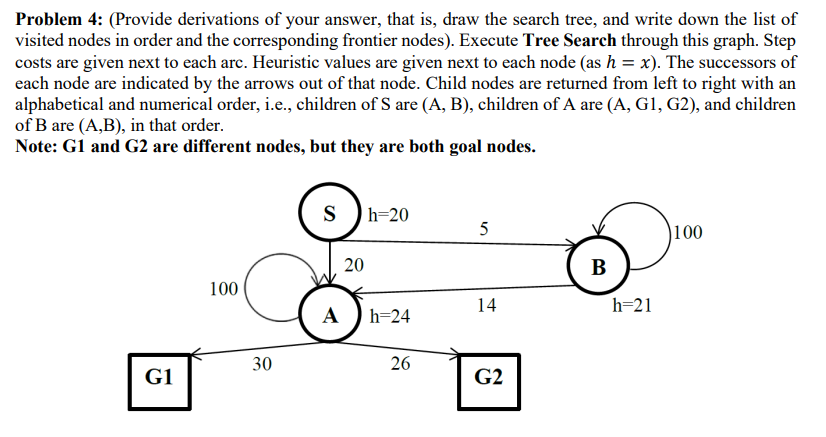Problem 4: (Provide derivations of your answer, that is, draw the search tree, and write down the list of visited nodes in order and the corresponding frontier nodes). Execute Tree Search through this graph. Step costs are given next to each arc. Heuristic values are given next to each node (as h = x). The successors of each node are indicated by the arrows out of that node. Child nodes are returned from left to right with an alphabetical and numerical order, i.e., children of S are (A, B), children of A are (A, G1, G2), and children of B are (A,B), in that order. Note: G1 and G2 are different nodes, but they are both goal nodes. S |h=20 5 100 20 B 100 14 h=21 A h=24
Problem 4: (Provide derivations of your answer, that is, draw the search tree, and write down the list of visited nodes in order and the corresponding frontier nodes). Execute Tree Search through this graph. Step costs are given next to each arc. Heuristic values are given next to each node (as h = x). The successors of each node are indicated by the arrows out of that node. Child nodes are returned from left to right with an alphabetical and numerical order, i.e., children of S are (A, B), children of A are (A, G1, G2), and children of B are (A,B), in that order. Note: G1 and G2 are different nodes, but they are both goal nodes. S |h=20 5 100 20 B 100 14 h=21 A h=24
Computer Networking: A Top-Down Approach (7th Edition)
7th Edition
ISBN:9780133594140
Author:James Kurose, Keith Ross
Publisher:James Kurose, Keith Ross
Chapter1: Computer Networks And The Internet
Section: Chapter Questions
Problem R1RQ: What is the difference between a host and an end system? List several different types of end...
Related questions
Question

Transcribed Image Text:Problem 4: (Provide derivations of your answer, that is, draw the search tree, and write down the list of
visited nodes in order and the corresponding frontier nodes). Execute Tree Search through this graph. Step
costs are given next to each arc. Heuristic values are given next to each node (as h = x). The successors of
each node are indicated by the arrows out of that node. Child nodes are returned from left to right with an
alphabetical and numerical order, i.e., children of S are (A, B), children of A are (A, G1, G2), and children
of B are (A,B), in that order.
Note: G1 and G2 are different nodes, but they are both goal nodes.
S
h=20
100
20
В
100
14
h=21
A ) h=24
30
26
G1
G2
Expert Solution
This question has been solved!
Explore an expertly crafted, step-by-step solution for a thorough understanding of key concepts.
This is a popular solution!
Trending now
This is a popular solution!
Step by step
Solved in 2 steps with 4 images

Recommended textbooks for you

Computer Networking: A Top-Down Approach (7th Edi…
Computer Engineering
ISBN:
9780133594140
Author:
James Kurose, Keith Ross
Publisher:
PEARSON

Computer Organization and Design MIPS Edition, Fi…
Computer Engineering
ISBN:
9780124077263
Author:
David A. Patterson, John L. Hennessy
Publisher:
Elsevier Science

Network+ Guide to Networks (MindTap Course List)
Computer Engineering
ISBN:
9781337569330
Author:
Jill West, Tamara Dean, Jean Andrews
Publisher:
Cengage Learning

Computer Networking: A Top-Down Approach (7th Edi…
Computer Engineering
ISBN:
9780133594140
Author:
James Kurose, Keith Ross
Publisher:
PEARSON

Computer Organization and Design MIPS Edition, Fi…
Computer Engineering
ISBN:
9780124077263
Author:
David A. Patterson, John L. Hennessy
Publisher:
Elsevier Science

Network+ Guide to Networks (MindTap Course List)
Computer Engineering
ISBN:
9781337569330
Author:
Jill West, Tamara Dean, Jean Andrews
Publisher:
Cengage Learning

Concepts of Database Management
Computer Engineering
ISBN:
9781337093422
Author:
Joy L. Starks, Philip J. Pratt, Mary Z. Last
Publisher:
Cengage Learning

Prelude to Programming
Computer Engineering
ISBN:
9780133750423
Author:
VENIT, Stewart
Publisher:
Pearson Education

Sc Business Data Communications and Networking, T…
Computer Engineering
ISBN:
9781119368830
Author:
FITZGERALD
Publisher:
WILEY